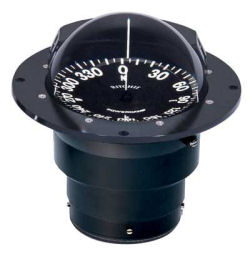Is the Compass Obsolete?
With GPS and chart plotters now making navigation literally child’s play, why does anyone need an old fashioned compass?
After all, isn’t it just an expensive piece of decoration that gets in one’s line
of sight? As a youngster once told us, “How boring, it’s always pointing the same
direction!” More and more, boat builders are leaving them off of new boats. We’re
told that the compass as a navigational device was invented by the Chinese before
1044 AD, so do you still need such old technology?

|
Taking up valuable dash board real estate, some builders are casting the venerable compass overboard. |
Wayne Spivak, United States Coast Guard Auxiliary, writing in Florida Sport Fishing
Magazine speaks for BoatTEST.com when he says--
You might well ask, “What in the world do I need a compass for? I just bought a
boat with a $5,000 GPS chart-plotter – the thing does everything but make coffee.”
Similar questions are replayed everyday by both seasoned salts and boating safety
instructors, and unfortunately, I think both groups are losing ground. Let me continue
by stating the following fact in unequivocal terms; if not already part of the package,
the very first piece of safety equipment that you purchase MUST be a compass - even
if it is not a Federal mandate.
Just in case you’re new to boating, a magnetic compass is an instrument used for
navigation. By reading the magnetic field of the Earth, a compass is able to tell
you the direction of the magnetic field. This direction - which essentially points
to the same place all over the globe, is designated “magnetic north.”
A Bit of History
Ancient mariners realized that a compass could be used in conjunction with a marine
chronometer to calculate longitude, and a sextant to calculate latitude - providing
a very accurate navigation capability. This device greatly improved maritime trade
by making travel safer and more efficient.
When did the needle start pointing to “North,” you ask? The origin of the compass
is shrouded in mystery. Certainly the Greeks knew about the attractive properties
of magnetism in ancient times. Nevertheless, the earliest compass dates back to
the 11th century with the Chinese taking credit for inventing the first maritime compass
sometime in the before 1044. The device hasn’t changed much since.
Magnetic Compass –vs– GPS/Chart-plotter
A marine compass is essentially a simple mechanical device with only one moving
part. In fact, many traditional compasses have a total of only three parts, a needle
that freely pivots, a pin for the needle to pivot on, and a compass rose. These
three items are typically sealed in some sort of liquid filled casing which prevents
the needle from fluctuating too much as the boat rocks back and forth, but even
that’s not necessary. A compass, unless demagnetized or thrown off by a stronger
local magnetic field, will always point to magnetic north. It requires no additional
internal or external components and costs anywhere from $20 and up.
A GPS/chart-plotter on the other hand, consists of hundreds of electrical components
that must be enclosed in a weatherproof casing. A GPS/chart-plotter requires an
energy source, reception of signals from multiple satellites which can be affected
by weather and electrical storms, and needs to be calibrated through the systems
setup menu. A typical GPS/chart-plotter costs from $500 to over $5000.
The GPS/chart plotter also needs electricity.
Still Not Sold?
Okay, so as a novice boater you’re still not sold on the importance of a basic maritime
compass. Let’s look at the skill it takes to use a compass versus a GPS/chart-plotter.
Unequivocal factoid number two; besides “Safe Boating,” all boaters should take
a basic course in simple maritime navigation. You need to be able to read a nautical
chart and plot a course on such chart. With this in mind, in order to properly read
a compass, you must know the direction in which you intend on traveling. That means
you need to plot your course so you can ascertain the proper heading, and then point
the bow of the boat in that same direction with nothing more than your compass.
Purists will tell you that you also need to apply TVMDC (True course +/- Variation
= Magnetic course +/- Deviation = Compass course). TVMDC is the method of converting
a true heading (that’s what you get on nautical charts) to a compass heading (that’s
what your compass reads) by applying corrections for variation (the change in the
magnetic field of the earth) and deviation (the local magnetic field on your boat
due to radios and other electronic equipment mounted near your compass). It sounds
more difficult than it actually is, but that’s why you should further your boating
education. With a GPS/chart-plotter, you need to plot your course, punch in each
waypoint along that course, and then have your GPS/chart-plotter tell you which
way your boat should be headed. Simple, right? Not so.
Don’t Forget the Juice
Oh, I almost forgot. A GPS/chart-plotter runs on electrical energy. Batteries die.
Electrical connections deteriorate and short-out. The display can burn-out or even
crack. Satellites incur problems and weather can degrade the satellite signal so
you can’t acquire a strong enough signal to establish a precise fix.
A compass runs on nothing more than the magnetic field of the earth. If the magnetic
field were to fail…well…you wouldn’t need to worry about the compass not working.
Sure, there is no question that boaters of all sizes should take full advantage
of modern technology and enjoy the multitude of benefits that come along with a
state-of-the-art GPS/chart-plotter, but for Heaven’s sake, if your boat is not already
equipped with one, buy a compass and learn how to use it – it will be one of the
smartest things you ever do!
Reprinted from Florida Sport
Fishing Magazine.